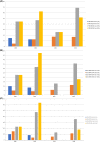Perinatal outcome of dichorionic and monochorionic-diamniotic Finnish twins: a historical cohort study
- PMID: 34780056
- PMCID: PMC9564548
- DOI: 10.1111/aogs.14285
Perinatal outcome of dichorionic and monochorionic-diamniotic Finnish twins: a historical cohort study
Abstract
Introduction: Although the perinatal mortality of monochorionic twins has been reported to be higher, the role of chorionicity is debated and data from Finland are still lacking. To examine the effect of chorionicity on the main outcome measures, perinatal and neonatal mortality and neonatal morbidity of Finnish twins, a comprehensive population-based historical cohort study was performed at Helsinki University Hospitals.
Material and methods: All 1034 dichorionic and monochorionic-diamniotic twin pregnancies managed at Helsinki University Hospital area during 2006, 2010, 2014 and 2018 were collected from patient databases. Information on chorionicity was retrieved from ultrasound reports and all relevant clinical information from patient records. Differences in perinatal and neonatal mortality and neonatal morbidity were analyzed by performing group comparisons between the twins and chorionicity. The role of chorionicity was also assessed in logistic regression analyses.
Results: There were 1034 dichorionic-diamniotic (DCDA, n = 789, 76.3%, 95% confidence interval [CI] 73.6-78.9) and monochorionic-diamniotic (MCDA, n = 245, 23.7%, 95% CI 21.4-26.0) twin pregnancies during the studied years. Most (n = 580, 56.1%, 95% CI 52.8-59.2) twins were born at term, but 151 (61.6%, 95% CI 55.8-67.3) of MCDA twins were preterm and had lower birthweight and Apgar scores and higher risk of death of one twin. Perinatal and neonatal mortality did not differ between twins A and B, but the immediate outcome of twin B was worse, with lower arterial pH and Apgar scores and increased need of neonatal intensive care unit treatment.
Conclusions: Chorionicity contributes to the perinatal and neonatal outcome in favor of dichorionic twins. This disadvantage of MCDA twinning is likely explained by earlier gestational age at birth and inequal placental sharing. Irrespective of chorionicity, twin B faces more complications.
Keywords: chorionicity; neonatal; perinatal mortality; pregnancy; twins.
© 2021 The Authors. Acta Obstetricia et Gynecologica Scandinavica published by John Wiley & Sons Ltd on behalf of Nordic Federation of Societies of Obstetrics and Gynecology (NFOG).
Conflict of interest statement
None.
Figures


References
-
- Siddiqui F, McEwan A. Twins. Obstet Gynaecol Reprod Med. 2007;17:289‐295.
-
- American College of Obstetricians and Gynecologists . Committee opinion No. 671: perinatal risks associated with assisted reproductive technology. Obstet Gynecol. 2016;128:e61‐e68. - PubMed
-
- Sultana R, Chen XK, Lee C, Hader J. Outcomes in multiple gestation pregnancies among Canadian women age 35 years and older. Healthc Q. 2011;14:22‐24. - PubMed
-
- Aston KI, Peterson CM, Carrell DT. Monozygotic twinning associated with assisted reproductive technologies: a review. Reproduction. 2008;136:377‐386. - PubMed
-
- Vasak B, Verhagen JJ, Koenen SV, et al. Lower perinatal mortality in preterm born twins than in singletons: a nationwide study from the Netherlands. Am J Obstet Gynecol. 2017;216:e1‐9. - PubMed
MeSH terms
Grants and funding
LinkOut - more resources
Full Text Sources
Medical

